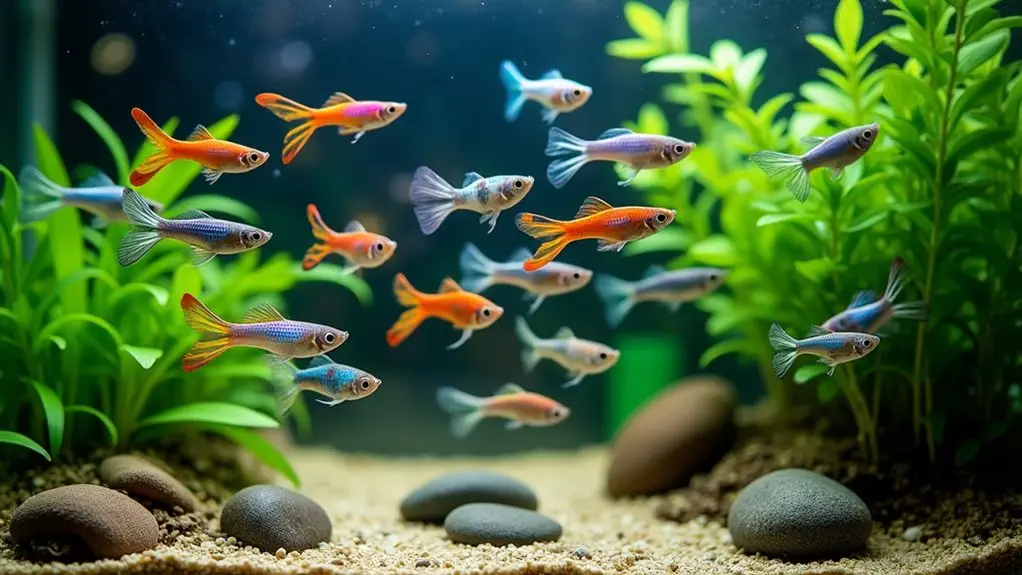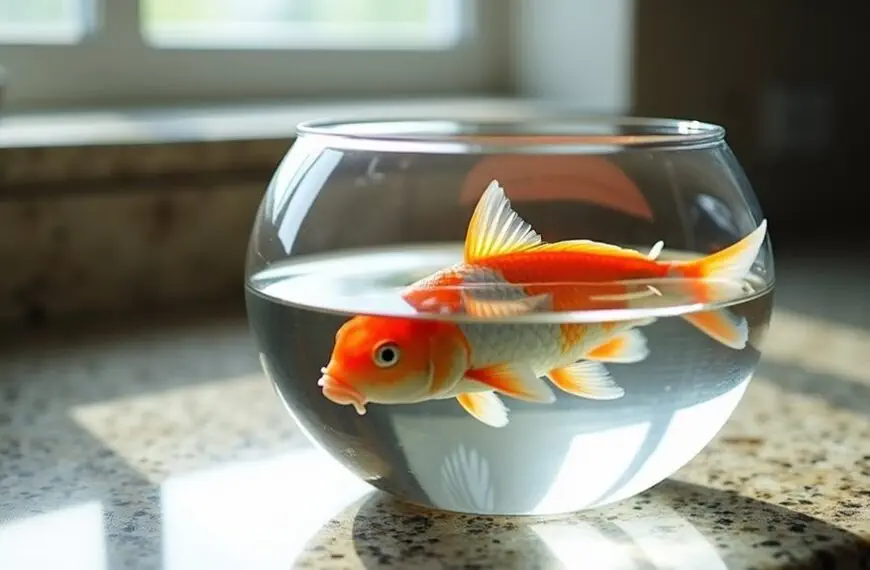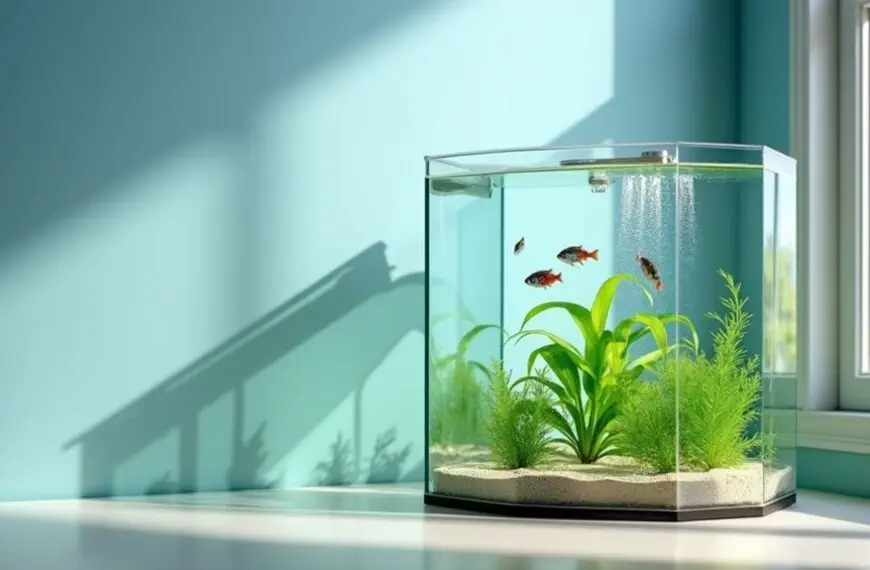You'll want to keep at least three guppies together, though six or more is ideal for these social swimmers. They're naturally schooling fish who thrive on interaction with their own kind, and keeping them in proper groups helps prevent stress and health issues. For a balanced community, aim for a ratio of one male to three or four females to reduce competition and create harmony in your aquarium. A group of 6-12 guppies creates the most natural environment, letting you witness their playful personalities and dynamic social behaviors. There's much more to take into account when creating the perfect guppy paradise.
Contents
- 1 Minimum Group Size Requirements
- 2 Tank Size and Stocking Numbers
- 3 Male and Female Ratios
- 4 Schooling Behavior Benefits
- 5 Managing Population Growth
- 6 Frequently Asked Questions
- 6.1 Can Different Color Strains of Guppies Be Kept Together Safely?
- 6.2 How Long Does It Take for Baby Guppies to Reach Adult Size?
- 6.3 Do Guppies Need Special Lighting Conditions to Maintain Their Bright Colors?
- 6.4 What Temperature Fluctuations Can Guppies Safely Tolerate in Their Tank?
- 6.5 Can Guppies Recognize and Bond With Their Tank Mates Over Time?
- 7 Final Thoughts
Minimum Group Size Requirements
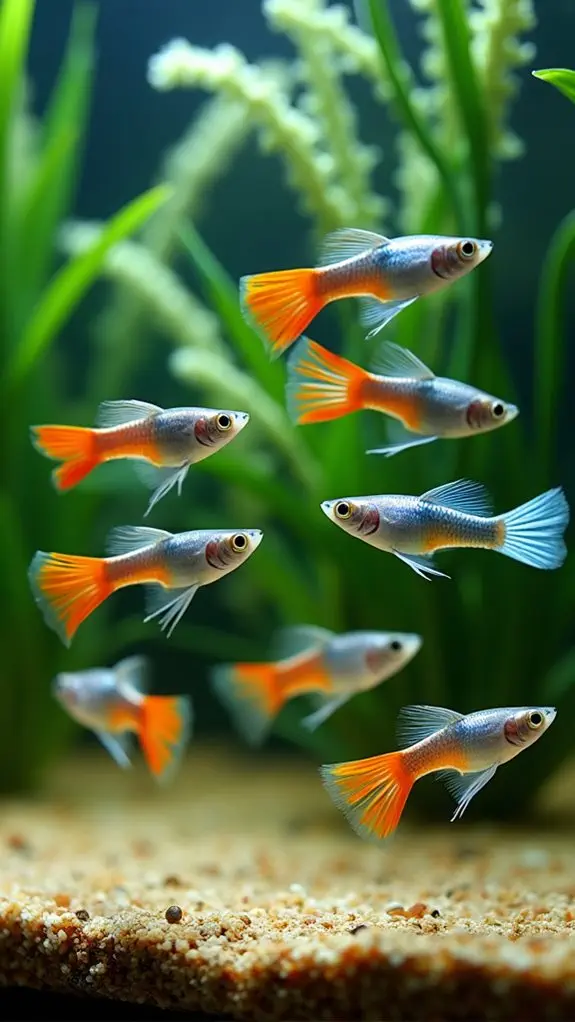
Guppies' social nature demands they live in groups of at least three, though six or more is ideal for their well-being. Like us, these colorful little swimmers need their social interaction to stay happy and healthy. Additionally, keeping them in groups allows them to exhibit their natural schooling behavior, which contributes positively to their overall health and happiness.
You'll find that keeping them in proper groups helps prevent stress, depression, and even health issues that can pop up when they're lonely.
If you're working with a 5-gallon tank, you'll want to start with a minimum of 2-4 guppies, though remember that group dynamics work best with at least three fish swimming together. Regular water changes are essential for maintaining healthy guppy groups in smaller tanks. When setting up groups, maintain a ratio of 2-3 females per male to prevent aggressive mating behaviors.
Think of it as creating a tiny underwater community – they'll school together occasionally and engage in natural behaviors that keep them stimulated. Just don't go overboard! While these social butterflies love company, overcrowding can lead to problems.
Never keep a guppy alone or in pairs – that's like sending them to solitary confinement! They're naturally social creatures who thrive on interaction with their own kind.
When you provide them with the right group size, you'll be rewarded with active, vibrant fish that showcase their best behaviors.
Tank Size and Stocking Numbers
Now that you understand how many guppies belong together, let's focus on giving them the right amount of space. When it comes to tank dimensions, you'll want to opt for a rectangular setup rather than a cube-shaped one, as this gives your guppies plenty of room to zoom around and show off their fins. Guppies tend to spend most of their time in the upper third of the tank, making vertical space less crucial than horizontal swimming area. Providing a large surface area is essential for optimal oxygen exchange, which supports the overall health of the fish.
Your stocking strategies should start with the basics: plan for at least 10 gallons if you're keeping an all-male group. While you might've heard the old "inch per gallon" rule, today's aquarium keeping is more sophisticated than that. Instead, think about providing each guppy with roughly 2 gallons of water to keep them happy and healthy. Since smaller fish like guppies have higher metabolic rates, they actually need more space per inch than larger fish species.
For the best results, you'll want to take into account both the tank's volume and surface area. A larger surface area means better oxygen exchange, which can support more fish.
Male and Female Ratios
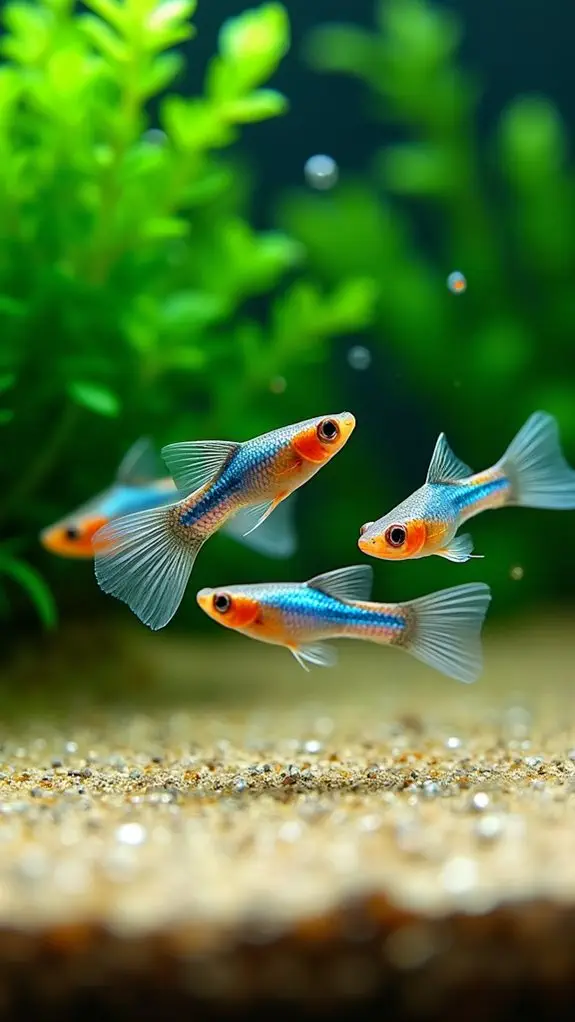
When it comes to maintaining harmony in your guppy tank, getting the right mix of males and females is essential for success. The breeding habits of guppies make it important to maintain proper ratios, as males can be quite persistent in their pursuit of females.
You'll want to aim for one male to every three or four females to keep aggression levels in check. With female guppies capable of producing 2-200 baby fish during each birth, maintaining the right ratio becomes even more crucial. Sufficient water volume is necessary to support your guppy population, with each fish requiring at least two gallons of water. Ensuring that your tank is well-cycled will significantly help in managing the water quality that guppies depend on.
If you've ever watched male guppies interact, you'll notice they can be quite the troublemakers! They'll often chase females and compete with other males, which isn't exactly peaceful tank life.
That's why having more females than males is significant – it helps spread out all that male attention and reduces stress on your female guppies. Think of it as creating a balanced social circle where everyone has enough space and companionship.
While you can keep a ratio of one male to two females, it's not ideal. The males might still become too competitive, and your females could end up stressed from constant attention.
Schooling Behavior Benefits
Beyond managing male-to-female ratios, understanding the benefits of schooling behavior can transform your guppy-keeping experience.
When you keep your guppies in proper schools, you'll notice they're not just happier – they're healthier too! These social butterflies of the aquarium world thrive on social interaction, which reduces their stress levels and even extends their lifespan. Guppies can form loose, flexible groups while swimming together, creating mesmerizing patterns throughout your aquarium. They frequently display tight clustering behavior when faced with new or stressful situations. Moreover, maintaining a minimum tank size is crucial to adequately support their schooling dynamics.
You'll be amazed at how schooling provides natural predator protection, as your guppies band together to confuse potential threats. It's like they're creating their own tiny neighborhood watch program!
When kept in groups of at least four to six, your guppies will establish fascinating social hierarchies and support systems that keep them active and engaged.
What's more, your schooling guppies will find and share food more efficiently, looking out for each other like tiny underwater families. They'll also breed more successfully when they're comfortable in their social groups.
Just remember to provide enough tank space for their schooling behavior – these little swimmers need room to show off their social skills and natural behaviors.
Your reward? A tank full of active, healthy, and absolutely entertaining guppies!
Managing Population Growth
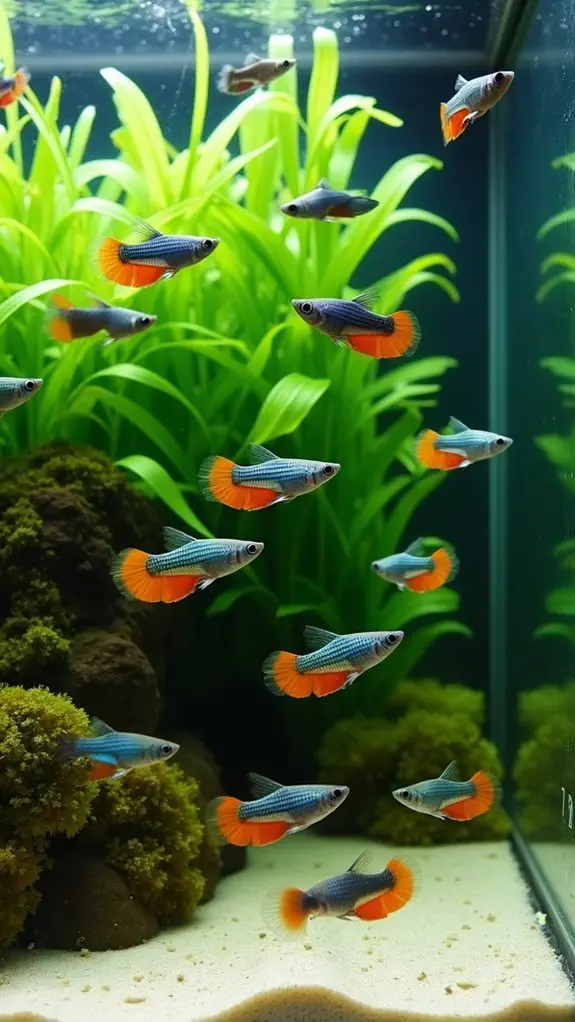
Every guppy keeper faces the challenge of population control, as these prolific breeders can quickly overwhelm your aquarium. If you've ever found yourself wondering where all these baby guppies came from, you're not alone! Implementing effective breeding strategies early on will save you from future headaches.
You've got several reliable methods to keep your guppy population in check. First, you'll want to maintain the right male-to-female ratio, aiming for one male to every 2-3 females. This not only controls breeding but also reduces stress in your tank. A heavily planted tank can provide hiding spots for fry, potentially increasing survival rates. Female guppies can produce offspring for up to six months after mating. Additionally, maintaining healthy water quality is crucial since poor conditions can lead to stress and increased mortality rates among guppies.
If you're comfortable with natural population control, adding peaceful predator fish like angelfish can help manage numbers, though you'll need to take into account how this affects other tank mates.
Environmental factors play an essential role too. Make sure you're providing adequate space, with at least 2 gallons per guppy.
If your numbers still grow too high, think about setting up a separate tank for excess fish. You can even turn this challenge into an opportunity by selling or rehoming your extra guppies to other enthusiasts.
Frequently Asked Questions
Can Different Color Strains of Guppies Be Kept Together Safely?
You can keep different color guppies together, but you'll need to contemplate strain compatibility. While purples and greens mix well, and reds work with albinos, avoid mixing variegated snakeskins with half-black reds.
How Long Does It Take for Baby Guppies to Reach Adult Size?
Your baby guppies will reach adult size in 3-4 months with ideal growth rates. You'll notice they grow quickly in the first few weeks, with size comparison showing dramatic changes until maturity.
Do Guppies Need Special Lighting Conditions to Maintain Their Bright Colors?
Yes, you'll need proper lighting requirements to maintain your guppies' color vibrancy. LED lights that mimic natural sunlight work best, and consistent day/night cycles help keep their colors bright and beautiful.
What Temperature Fluctuations Can Guppies Safely Tolerate in Their Tank?
You'll want to maintain your guppies' temperature range between 72-82°F, allowing no more than 2°F change in 24 hours. Larger fluctuations will increase stress levels and risk their health considerably.
Can Guppies Recognize and Bond With Their Tank Mates Over Time?
Yes, your guppies will recognize and bond with tank mates as they develop social behavior through familiarity. They'll form equitable associations over time, creating harmonious tank dynamics when given proper opportunities to interact regularly.
Final Thoughts
You'll find that keeping guppies is all about finding the right balance. For the happiest, healthiest fish, aim to maintain at least 4-6 guppies together, with a ratio of 2-3 females for every male. Remember, they're social creatures who thrive in groups, but you'll need to keep an eye on breeding to prevent overcrowding. With proper planning and the right setup, you'll create a vibrant, active community that's a joy to watch.

